#OrthopedicDoctor
Text
Pre and Post Total Knee Replacement Patient Success Story
Knee pain kept me on the sidelines for too long. Missing out on hiking trips, struggling to spend time with grandchildren – this was not the life I wanted
Then, I decided to explore total knee replacement. The surgery was a game-changer!
Thank you Dr. Jain for his amazing surgery! The recovery walk wasn't easy, but with dedication and Dr. Vaibhav's guidance, I feel like myself again - stronger than ever!
Thinking about knee replacement? Don't let pain hold you back! It could be the key to unlocking a world of possibilities.
Get in touch with Dr. Vaibhav Jain:
WhatsApp: +91 9289084372
Website: www.drvaibhavjain.com
2 notes
·
View notes
Text
Drill Machine
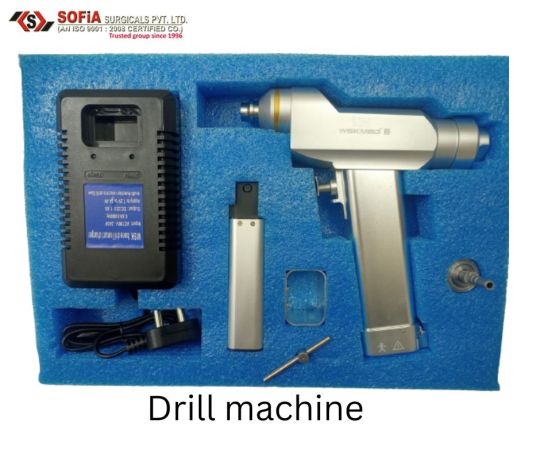
For more detail visit our website: www.sofiasurgicals.com
Call us or whatsapp on +919015555501
Email - sofias
#drillmachine
#orthopedicplates#surgicalinstruments#orthopedicsurgery#orthopedicsurgeon#orthopedicscrews#boneplate#orthopedic#orthopedics#orthopedicdoctor#lockingplates#orthoimplants#orthopedicimplants#orthoimplant#orthoimplantegroup#orthopedicimplant#surgicalimplant#ortho#lockingplate#bonefracture#bonefractures#surgicalimplants#orthopaedicimplant#orthopedicinstruments#dhsplate#titaniumimplant#medicalequipment#titaniumplate#hipprosthesis#surgicaltechnologist#austinmorehipprosthesis
2 notes
·
View notes
Text
Patellofemoral Pain Syndrome | Patellofemoral Pain Sets Treatment by Dr Amit Meena
Patellofemoral Pain Syndrome
Patellofemoral pain syndrome, also known as chondromalacia patella, runner’s knee, or moviegoer’s knee, is a condition characterized by discomfort in the patellofemoral joint, which includes the kneecap and the front part of the femur. This condition typically arises from overuse rather than a traumatic injury, and it can manifest during various activities, both athletic and every day.
Patients often notice this pain when:
Walking up or down stairs
Transitioning from sitting to standing
After extended periods of sitting
Running or engaging in athletic activities
Squatting, kneeling, or lunging
The discomfort can also be triggered by wearing high heels. While it may be more noticeable during activities that place extra stress on the patellofemoral joint, the pain is generally less pronounced when walking on level ground.
Dr. Amit Meena emphasizes that, upon examination, the pain is frequently located at the lower and outer edges of the kneecap, beneath the patella, and on the outer side of the knee. In cases of heightened inflammation, patients may experience diffuse pain throughout the entire joint.
The syndrome is often associated with an uneven distribution of stress under the kneecap, leading to discomfort. This irregular stress distribution can be attributed to an abnormal tilt of the patella, which is sometimes visible on X-rays. However, it can also occur in individuals with normal X-rays, often due to weakness in the large muscle groups of the leg. When patellofemoral pain sets in, it inhibits the quadriceps muscle, the major muscle in the front of the thigh, from effectively unloading stress on the kneecap. As a result, the pain can progressively worsen.
The syndrome is often associated with an uneven distribution of stress under the kneecap, leading to discomfort. This irregular stress distribution can be attributed to an abnormal tilt of the patella, which is sometimes visible on X-rays. However, it can also occur in individuals with normal X-rays, often due to weakness in the large muscle groups of the leg. When patellofemoral pain sets in, it inhibits the quadriceps muscle, the major muscle in the front of the thigh, from effectively unloading stress on the kneecap. As a result, the pain can progressively worsen.
Patellofemoral pain syndrome, as well as other patellar issues, is more commonly observed in women than in men. Women often adopt a valgus or knock-kneed posture, which naturally pulls the patella toward the outside of the leg, subjecting the knee to uneven stress distribution.
Tight muscles and soft tissues supporting the knee, including the hamstrings and the iliotibial (IT) band, can contribute to this condition. Conversely, women with hypermobile or loose soft tissues can develop the syndrome due to muscle weakness and the inability of supporting muscles to balance or unload the patella, allowing it to be pulled laterally away from the trochlea.
Orthopedic surgeons and sports medicine specialists conduct a comprehensive physical examination to evaluate patellofemoral pain. This assessment includes identifying any imbalances from the feet to the hips. Additional factors that can exacerbate pain include flat feet, abnormal hip rotation, IT band tightness, and issues with hip flexors. In some cases, MRI and X-ray imaging are utilized to assess the bones, alignment, and cartilage surfaces of the kneecap and trochlea, providing a more comprehensive understanding of the condition.

Treatment
Dr. Amit Meena emphasizes that the majority of individuals dealing with patellofemoral pain syndrome can effectively manage their condition without the need for surgery. The initial focus of treatment is to provide relief and “quiet the knee.” This is achieved through various non-operative methods.
Anti-inflammatory medications and the application of ice play a crucial role in reducing inflammation and discomfort. It’s essential to give your knee some rest and modify activities that exacerbate the condition. This might involve temporarily avoiding high-impact sports, intense workouts, squatting, lunging, and minimizing stair climbing.
In cases where anatomical factors like flat feet are contributing to the issue, orthotics may be recommended. For runners, if landing irregularities, such as pronation or supination, are a part of the problem, a change in footwear may be necessary. Sometimes, a cortisone injection can help reduce knee inflammation, making it more tolerable for the patient to engage in a stretching and strengthening program.
A structured physical therapy regimen is initiated to address tight tissues, enhance structural strength throughout the leg and hip, and promote overall recovery. If the expected improvements aren’t achieved through physical therapy, further imaging, such as an MRI with specialized sequences, may be recommended to assess early cartilage changes.
Dr. Amit Meena highlights that a procedure known as a “lateral release” can be beneficial when performed in conjunction with more extensive surgeries like a tibial tubercle osteotomy or a medial patellofemoral ligament (MPLF) reconstruction, as part of a comprehensive soft tissue balancing approach. However, as an isolated procedure, it is suitable for only a very small subset of patients. This includes individuals with a tilted patella, intact cartilage, and a lack of improvement despite extensive physical therapy. It’s important to note that more than 95% of patients with patellofemoral pain syndrome do not require surgery.
Managing patellofemoral pain syndrome is often successful through non-operative treatments tailored to the individual’s specific condition and needs. Surgery is typically reserved for a select group of patients who have specific, well-defined indications.
0 notes
Text
Arthritis Diagnosis and Treatment in Gurgaon
Understanding Arthritis: Diagnosis and Treatment Options in Gurgaon
Arthritis is a common condition that affects millions of people worldwide, causing pain, stiffness, and reduced mobility in joints. In Gurgaon, Dr. Hemant Sharma offers comprehensive diagnosis and advanced treatment options for arthritis, helping patients manage symptoms and improve their quality of life. Here’s everything you need to know about arthritis diagnosis and treatment at Dr. Hemant Sharma’s clinic.
What is Arthritis?
Arthritis refers to inflammation of one or more joints, leading to pain, swelling, stiffness, and decreased range of motion. There are several types of arthritis, including osteoarthritis (most common), rheumatoid arthritis, and gout, each requiring different approaches to diagnosis and treatment.
Diagnosis of Arthritis
Diagnosing arthritis typically involves a combination of medical history review, physical examination, imaging tests, and laboratory tests. Dr. Hemant Sharma employs a thorough diagnostic approach to accurately identify the type and severity of arthritis, which is crucial for developing an effective treatment plan.
Medical History: Discussing symptoms, previous injuries, and family history of arthritis.
Physical Examination: Assessing joint function, swelling, and range of motion.
Imaging Tests: X-rays, MRI scans, or ultrasound to visualize joint damage.
Lab Tests: Blood tests to detect inflammation markers and antibodies in autoimmune forms of arthritis.
Treatment Options for Arthritis
Dr. Hemant Sharma offers personalized treatment plans based on the specific type and stage of arthritis, focusing on relieving pain, reducing inflammation, preserving joint function, and improving overall quality of life. Treatment options may include:
Medications: Pain relievers, anti-inflammatory drugs, disease-modifying antirheumatic drugs (DMARDs), or biologic agents.
Physical Therapy: Exercises to strengthen muscles around the joints, improve flexibility, and reduce stiffness.
Joint Injections: Corticosteroids or hyaluronic acid injections to alleviate pain and inflammation.
Lifestyle Modifications: Weight management, ergonomic adjustments, and adaptive devices to reduce stress on joints.
Surgery: In cases of severe joint damage, Dr. Hemant Sharma may recommend joint replacement surgery (such as knee or hip replacement) or arthroscopic surgery for diagnostic and therapeutic purposes.
Comprehensive Care and Support
At Dr. Hemant Sharma’s clinic, patients benefit from compassionate care, expert guidance, and ongoing support throughout their arthritis treatment journey. Dr. Sharma emphasizes patient education, empowering individuals to actively participate in managing their arthritis and making informed decisions about their health.
Contact Dr. Hemant Sharma’s Clinic
If you or a loved one are experiencing joint pain or suspect arthritis, don’t wait to seek help. Visit Dr. Hemant Sharma’s official website to schedule a consultation and learn more about arthritis diagnosis and treatment options in Gurgaon. Take the first step towards managing your arthritis symptoms and improving your quality of life with expert care from Dr. Hemant Sharma. Your journey to better joint health starts here!
0 notes
Text
Top Orthopedic Doctor in Selaiyur: Expert Care Awaits

Are you searching for an exceptional orthopedic doctor in Selaiyur? Look no further! At ORTHODERM, we pride ourselves on providing top-notch orthopedic care tailored to your needs. Our skilled team of specialists offers comprehensive services ranging from diagnosis to advanced treatments. Whether you’re dealing with joint pain, fractures, or other orthopedic conditions, our dedicated professionals at ORTHODERM ensure you receive the best possible care. Visit us to experience expert treatment and personalized attention.
0 notes
Text

🔍 Understanding Angular Deformity: Symptoms & Treatments! 🌟
Angular deformity refers to the abnormal alignment of bones, often seen in the legs or arms. Symptoms include visible misalignment, pain, and difficulty in movement.
Early diagnosis and treatment are crucial! Treatments range from physical therapy and braces to surgical intervention. If you're experiencing any of these symptoms, consult an orthopedic doctor in Mulund, Mumbai for expert care.
0 notes
Text
Dr. Sachin R. Kurukalikar - Orthopedic Doctor in Navi Mumbai
Dr. Sachin R. Kurukalikar, leading orthopedic doctor in Navi Mumbai, specializes in providing personalized care for all musculoskeletal conditions. Trust in his expertise for comprehensive orthopedic treatment and surgical solutions. Contact us today for a consultation.
For more information : https://goo.gl/maps/ckUxWuYhbNXXBYuF8
#DrSachinRKurukalikar#OrthopedicDoctor#NaviMumbai#BoneHealth#OrthopedicCare#JointPainRelief#OrthopedicSurgeon#OrthopedicSpecialist#OrthopedicClinic#HealthyBones
0 notes
Text
6 Tips to Help Speed Your Recovery Following Knee Replacement Surgery
Every year, more than 600,000 men and women in the India get knee replacement surgery. This safe and very successful technique has various advantages, including treating leg problems, knee pain, and restoring mobility.
Knee replacement operations have progressed significantly since the initial treatment in 1968.
Dr. Sanjay Rawat offers cutting-edge ways to arthritis therapy. At his cutting-edge clinic, Dr. Sanjay Rawat Orthopaedics Idaho, treatments may include nonsurgical techniques, arthroscopic procedures, and joint replacement.
If you're undergoing knee replacement surgery, Dr. Sanjay Rawat suggests the following five measures to help you recuperate as rapidly as possible.
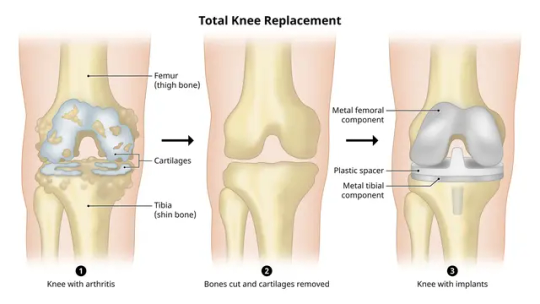
1. Keep your knees straight
It's wrong to sit back and put your leg on a cushion following knee surgery, but you should maintain the joint perfectly straight.
When lying down or sitting, keep your leg and foot facing straight forward to help the healing process. You should also avoid sitting in the same posture for more than 45-60 minutes at a time and choose for a sturdy chair with armrests and a straight back rather than stools, soft couches, or low chairs.
2. Watch your step
While your joint heals, you must take additional care to preserve your knee replacement. This involves sitting for extra stability when getting dressed or showering, as well as taking short steps while standing.
In most cases , you might anticipate to need crutches or a walker four to six weeks after your treatment. When on your feet, use sturdy shoes with nonslip bottoms. When moving, keep your toes straight forward and avoid pivoting on your new joint.
3. Use your medical devices
After having knee replacement surgery, you can expect to have supportive devices, like wheelchairs, crutches, walkers, canes, or knee braces to help aid your recovery and no matter how strong you feel, you should always follow Dr. Sanjay Rawat guidelines on their use. Not only do these devices provide greater stability when you’re on your feet, but they also help give your new joint additional support as it heals.
4. Do not skip your physical treatment
Physical therapy may make you moan, but these specific workouts are necessary for healing. At the same time, you should only participate in activities approved by Dr. Sanjay Rawat. These vary from person to person and may include:
Walking
Leg presses using resistance bands.
Extend and bend your knees whether sitting or swimming.
Remember, don't engage in activities without prior consent, or you may reinjure your knee and prolong your healing period.
5. Consume a balanced diet
It is rather common to experience an appetite loss in the starting days following surgery. But as soon as possible following your treatment, you should start consuming foods, particularly those high in iron. An essential mineral called iron aids in the transportation of oxygen throughout the body, promoting healing.
6. Avoid becoming inactive
Please do your hardest and keep going even though exercising hurts. Always have a balance between continuing your exercise and not overdoing it. While healing, there will be numerous days; on some, you'll feel more in shape, and on others, you'll be in agony. You should check to see if your exercises are becoming a little bit simpler each day. It is advised that you speak with your physician to find out which exercises are right for you
#backpainrelief#kneepainrelief#totalkneereplacement#sportsinjury#orthopedicdoctor#hipreplacementsurgery#hippain#shouldersurgery
0 notes
Text

💪 Stronger Hips, Better Life!
If hip pain is slowing you down, it’s time to take control. Hip replacement surgery with Dr. Vaibhav Jain can help you regain your mobility and live pain-free.
Book your consultation today and start your journey to a healthier, more active life!
📱 WhatsApp: +91 9289084372
🌐 Website: www.drvaibhavjain.com
#HipReplacement#NoidaDoctor#OrthopedicDoctor#StrongerHips#OrthopedicCare#DrVaibhavJain#HipHealth#Noida#Delhi#Faridabad
1 note
·
View note
Text
Orthopaedic Care for Athletes and Active People
Orthopaedic care is essential for athletes of all levels, from recreational to elite. By understanding the unique orthopaedic needs of athletes, orthopaedic specialists can provide tailored care that helps athletes to prevent injuries, recover quickly from injuries, and achieve their performance goals.
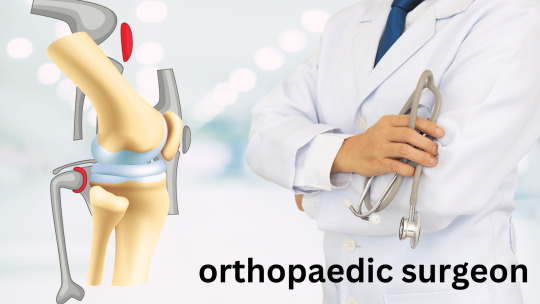
Non-surgical orthopaedic treatments are often the first line of defense for orthopaedic injuries in athletes. These treatments can be effective in relieving pain, reducing inflammation, and improving function. Common non-surgical treatments include:
Physiotherapy: Physiotherapists use a variety of techniques to help athletes regain their range of motion, strength, and function. These techniques may include exercises, manual therapy, and modalities such as heat, ice, and electrical stimulation.
Medications: Orthopaedic specialists may prescribe medications to help athletes manage their pain and inflammation. Common medications include over-the-counter pain relievers, nonsteroidal anti-inflammatory drugs (NSAIDs), and corticosteroids.
Orthotics and bracing: Orthotics and bracing can be used to provide support and stability to injured joints. This can help to reduce pain and swelling, and promote healing.
If non-surgical treatments are not effective, or if the injury is severe or complex, surgery may be necessary. Common surgical orthopaedic interventions for athletes include:
Arthroscopy: Arthroscopy is a minimally invasive surgical procedure that can be used to diagnose and treat joint problems. A small camera is inserted into the joint through a small incision, and the surgeon can use specialized instruments to view and repair damaged tissues.
Ligament repair: Surgery may be used to repair torn ligaments, such as the ACL or PCL. This may involve suturing the torn ligament back together, or using a graft from another part of the body to replace the damaged ligament.
Tendon repair: Surgery may be used to repair torn tendons, such as the Achilles tendon or rotator cuff tendon. This may involve suturing the torn tendon back together, or using a graft from another part of the body to augment the repair.
Fracture repair: Surgery may be used to repair broken bones. This may involve open reduction internal fixation (ORIF), in which the broken bone is aligned and held in place with metal screws, plates, or nails. Or, it may involve closed reduction internal fixation (CRIF), in which the broken bone is aligned and held in place without
Once surgery has been performed, it is important for athletes to follow their surgeon's instructions carefully during the rehabilitation process. This will help to ensure a successful recovery and a return to play as soon as possible.
Rehabilitation after orthopaedic surgery typically includes a combination of physical therapy, occupational therapy, and strength and conditioning training. The specific goals of rehabilitation will vary depending on the type of surgery performed, but the overall goal is to help athletes regain their range of motion, strength, and function.
Physical therapy is an essential part of rehabilitation after orthopaedic surgery. Physical therapists can help athletes to:
Reduce pain and inflammation
Improve range of motion
Strengthen muscles around the injured area
Restore balance and coordination
Learn how to prevent future injuries
Occupational therapy may also be recommended for athletes after orthopaedic surgery. Occupational therapists can help athletes to learn how to perform activities of daily living (ADLs), such as bathing, dressing, and cooking, with the injured area. They can also help athletes to develop strategies for returning to work or school.
Strength and conditioning training is another important component of rehabilitation after orthopaedic surgery. Strength and conditioning coaches can help athletes to:
Build strength and power
Improve cardiovascular fitness
Improve proprioception (awareness of the body's position in space)
Reduce the risk of re-injury
It is important for athletes to be patient and realistic during the rehabilitation process. Healing takes time, and it is important to not rush the process. By following their surgeon's instructions and working hard in rehabilitation, athletes can maximize their chances of a successful recovery and a return to play.
Here are some additional tips for athletes who are recovering from orthopaedic surgery:
Listen to your body. Don't push yourself too hard, and don't be afraid to rest when you need to.
Be consistent with your rehabilitation exercises. Even if you're feeling better, it's important to continue doing your exercises to maintain your progress.
Communicate with your surgeon and physical therapist. If you have any questions or concerns, don't be afraid to ask.
Be patient. Healing takes time. Don't expect to be back to 100% overnight.
By following these tips, athletes can increase their chances of a successful recovery from orthopaedic surgery and a return to play.
#orthopedicsurgeon#orthopaedicsurgeon#orthopedicdoctor#orthopaedicdoctor#orthopaedicsurgeonsingapore
0 notes
Text
Best Knee Replacement in Jaipur | Knee Surgery Knee Surgeon in Jaipur
KNEECARES – The Superspeciality Knee Clinic, led by world-renowned knee surgeon Dr Amit Meena, India's best clinic for Knee Replacement & knee Ligament Surgery in Jaipur, Rajasthan

#Orthopedicdoctor#OrthopaedicDoctorinJaipur#jointreplacementsurgeoninJaipur#KneePainDiagnosisandtreatment
0 notes
Text
Best orthopedic surgeon doctor in Gurgaon
Choosing Excellence: Discovering the Best Orthopedic Surgeon in Gurgaon - Dr. Hemant Sharma
Finding the right orthopedic surgeon is crucial for effective treatment and recovery from musculoskeletal issues. In Gurgaon, Dr. Hemant Sharma emerges as a standout choice among orthopedic surgeons, renowned for his expertise, dedication to patient care, and advanced treatment options. Here’s why Dr. Hemant Sharma is widely regarded as the best orthopedic surgeon in Gurgaon.
Expertise and Experience
Dr. Hemant Sharma brings over [X years] of extensive experience in orthopedic surgery to his practice. His expertise spans a wide range of orthopedic conditions, including joint replacements, sports injuries, spinal disorders, and trauma care. He is known for his meticulous approach to diagnosis and treatment, ensuring accurate assessment and personalized care plans for each patient.
Comprehensive Orthopedic Services
At Dr. Hemant Sharma’s clinic, patients benefit from a comprehensive range of orthopedic services, including:
Joint Replacement Surgeries: Hip, knee, shoulder replacements.
Sports Medicine: Treatment for sports-related injuries, arthroscopic surgeries.
Spine Surgeries: Management of spinal conditions, including herniated discs and spinal deformities.
Trauma and Fracture Care: Immediate treatment and rehabilitation for orthopedic emergencies.
Orthopedic Rehabilitation: Post-operative care and physical therapy to aid recovery and restore functionality.
Advanced Treatment Techniques
Dr. Hemant Sharma stays at the forefront of medical innovation, incorporating advanced treatment techniques into his practice. This includes minimally invasive surgeries, robotic-assisted surgeries for enhanced precision, and personalized rehabilitation plans tailored to individual patient needs. His commitment to utilizing the latest technology ensures that patients receive the highest standard of care with optimal outcomes.
Patient-Centered Care Approach
What sets Dr. Hemant Sharma apart is his patient-centered approach to healthcare. He prioritizes clear communication, compassionate care, and patient education throughout the treatment journey. Dr. Sharma takes the time to listen to patient concerns, explain treatment options comprehensively, and involve patients in decision-making regarding their orthopedic care.
Testimonials from Satisfied Patients
Here are testimonials from patients who have experienced Dr. Hemant Sharma’s exceptional care:
"Dr. Hemant Sharma’s expertise and personalized approach made my knee surgery a success. I am grateful for his skill and dedication."
"I highly recommend Dr. Hemant Sharma for anyone seeking top-notch orthopedic care in Gurgaon. He is truly the best!"
Contact Dr. Hemant Sharma Today
Ready to consult with the best orthopedic surgeon in Gurgaon? Visit Dr. Hemant Sharma’s official website to schedule an appointment or learn more about the services offered. Whether you require joint replacement surgery, treatment for a sports injury, or relief from spinal discomfort, Dr. Hemant Sharma and his compassionate team are committed to providing exceptional care and helping you achieve optimal musculoskeletal health. Take the first step towards a pain-free and active life with Dr. Hemant Sharma in Gurgaon today!
0 notes
Text
#orthopedics#orthopedicsurgery#orthopedicsurgeon#orthopedicspecialist#orthopedicdoctor#orthopedicsurgerylife#orthopedicsurgerylove#orthopedicdoctorlife#orthopedicdoctorlove#orthopedicsurgical#orthopedicteam#orthopediccommunity#orthopedics4life#orthopedicsurgery4life#orthopedicdoctor4life#orthopedicssupport#orthopedicstreatment#orthopediccare#orthopedicrecovery#orthopedicsurgeonlife#orthopedicdoctortraining#orthopedicmedicalstudent#orthopedicresident#orthopedicfellowship#orthopedicconference#orthopedicresearch#orthopedicjournal#orthopedicbook#orthopedicpodcast
0 notes
Text
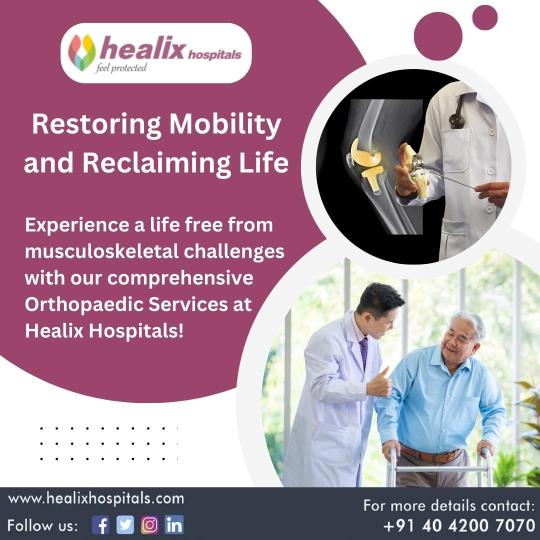
𝗥𝗲𝘀𝘁𝗼𝗿𝗶𝗻𝗴 𝗠𝗼𝗯𝗶𝗹𝗶𝘁𝘆 𝗮𝗻𝗱 𝗥𝗲𝗰𝗹𝗮𝗶𝗺𝗶𝗻𝗴 𝗟𝗶𝗳𝗲: 𝗢𝗿𝘁𝗵𝗼𝗽𝗮𝗲𝗱𝗶𝗰 𝗦𝗲𝗿𝘃𝗶𝗰𝗲𝘀 𝗮𝘁 𝗛𝗲𝗮𝗹𝗶𝘅 𝗛𝗼𝘀𝗽𝗶𝘁𝗮𝗹𝘀
Experience a life free from musculoskeletal challenges with our comprehensive Orthopaedic Services at Healix Hospitals! 🏥✨
Our team of skilled #orthopaedic specialists is dedicated to diagnosing, treating, and rehabilitating a wide range of conditions. 👍
From joint replacements to sports injuries, we're here to restore your mobility and help you reclaim an active, pain-free lifestyle.
Your journey to better #musculoskeletalhealth starts here. 💪🌈
Contact information :
☎️ Call us on +91 40-4200-7070
👉 Visit : https://www.healixhospitals.com/contact
#orthopedicdoctor#orthopedic#orthopedicsurgeon#rheumatoidarthritis#discprolapse#spondylosis#orthopaedic#orthopedicsurgery#ortholife#osteoarthritis#osteoarthritistreatment#backpain#Painrelief#healthyspine#Jointpains#orthocare#OrthopaedicCare#MobilityRestored#HealthyMovement#HealixHospitals
0 notes
Text
#heart#heartspecialist#vamsimohan#criticalcaremedicine#criticalcaremedicinehyderabad#criticalcaremedicinenearme#enthospital#ENTSpecialist#PragmaHospital#besthospital#vanasthalipuram#bestdoctor#besthospitalnearme#besthearthospital#bestorthopedicdoctor#liverproblems#bestorthopedicdoctornearme#bestorthopedichospital#bestorthopedic#orthopedicdoctor#orthopedichospital#liverhospita#liverhospitanearme#thyroidtreatment#thyroidhospital#cardiology#cardiothoracicsurgeons#cardiologists
0 notes
Text
Orthopedic Doctor In Nallagandla
Looking for an expert Orthopedic Doctor In Nallagandla? Look no further than Aksha Hospital! Our specialized team of orthopedic surgeons is dedicated to providing top-notch care and innovative treatments for all musculoskeletal conditions. Whether you need joint replacements, sports injury treatment, or personalized orthopedic care, our state-of-the-art facility and experienced doctors are here to help you regain mobility and live pain-free. Book your appointment today at Aksha Hospital and experience exceptional orthopedic care in Nallagandla.
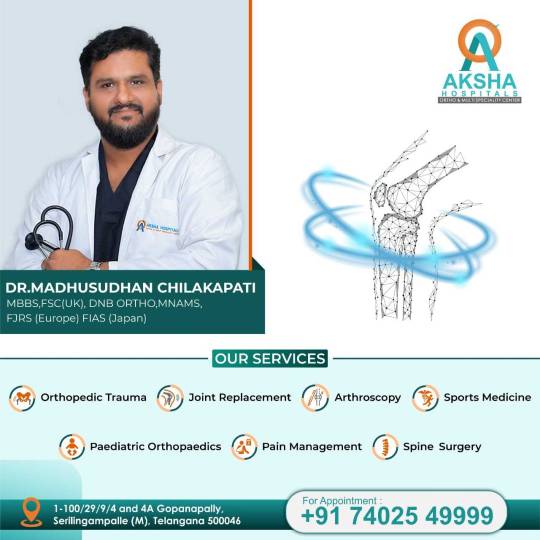
0 notes